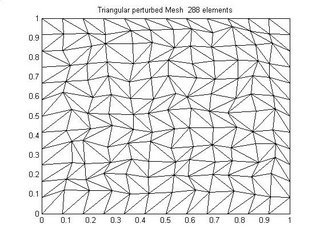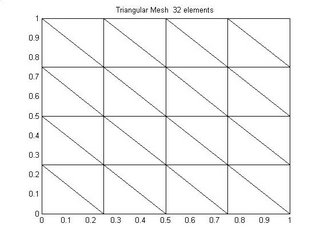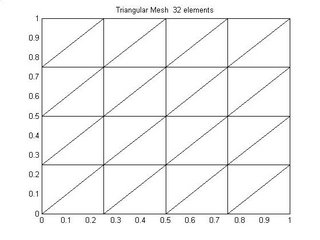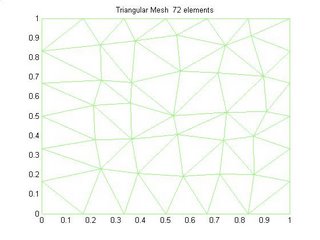Saturday, April 10, 2010
Website moved
Enjoy browsing.
Cheers
Pavon
Tuesday, November 07, 2006
Unstructured 2D Triangular Mesh Matlab

Figure 1 Unstructured Mesh
Triangular meshs can also be structured triangular with triangulation in some particular direction as shown in figure 2 and figure 3.


The Unstructured mesh shown in Figure 1 is basically made by randomly perturbing the nodes of a unifrom triangular mesh and it look very much like a delaunay mesh. Figure 4 shows a unstructured triangular delaunay mesh.

Now comming to How to generate shuch kind of meshes. I will here give a simple example of generating regular structured triangular mesh.
The code below is used to create the above triangular structured mesh
x=[0:1/(numx):1];
y=[0:1/(numy):1]; %Matlab's meshgrid is used to create 2D grid from specified divisons above
[X,Y] = meshgrid(x,y);
X1=reshape(X',length(x)*length(y),1);
Y1=reshape(Y',length(x)*length(y),1); %Coordinates of the node
node=[X1 Y1]; % Node
tri = triangulate(X1,Y1,element); % element connectivity
nele = size(tri,1);
Z= zeros(length(y)-2,length(x)-2);
nn = tri; % nodes in a long list
xx = X1(nn); yy = Y1(nn); % coordinates corresponding to nodes
xplot = reshape(xx,size(tri));
yplot = reshape(yy,size(tri));figure(1);
clf;
fill(xplot',yplot','w');
title(['Triangular Mesh ', num2str(length(nn)),' elements'])
%%%%%%Subfunction % triangulate
function tri = triangulate(xnod,ynod,nodes)
%
% tri = triangulate(xnod,ynod,nodes)
%
% triangulate the quadrilateral mesh
%
nele = size(nodes,1);
tri = zeros(3,2*nele)';
iv = [];
ii1 = [2 3 1];
jj1 = [4 1 3];
ii2 = [1 2 4];
jj2 = [2 3 4];
nrtri = 0;
for iel = 1:nele
iv = nodes(iel,:);
d1 = norm([xnod(iv(1))-xnod(iv(3));ynod(iv(1))-ynod(iv(3))]);
d2 = norm([xnod(iv(2))-xnod(iv(4));ynod(iv(2))-ynod(iv(4))]);
if d1 <= d2
nrtri = nrtri+1;
tri(nrtri,:) = iv(ii1);
nrtri = nrtri+1;
tri(nrtri,:) = iv(jj1);
else
nrtri = nrtri+1;
tri(nrtri,:) = iv(ii2);
nrtri = nrtri+1;
tri(nrtri,:) = iv(jj2);
end
end
This code will enable any one to generate a regular triangular mesh and different changes can be made to this code to get other kind of Triangular meshes as shown in figure 1 -4
Wednesday, November 01, 2006
Mesh Generation Using MATLAB Delaunay Function
[X,Y,Z] = meshgrid(x,y,z);
This gives me a tetrahedral mesh with 'Tes' having the nodal connectivity matrix for a typical case (a cube with 6-tetrahedra, 8 nodes)it looks like
function [vertices,tess]=tess_lat(varargin)
% tess_lat: simplicial tessellation of a rectangular lattice
% usage: [tessellation,vertices]=tess_lat(p1,p2,p3,...)
%
% arguments: input
% p1,p2,p3,... - numeric vectors defining the lattice in
% each dimension.
% Each vector must be of length >= 1
%
% arguments: (output)
% vertices - factorial lattice created from (p1,p2,p3,...)
% Each row of this array is one node in the lattice
% tess - integer array defining simplexes as references to
% rows of "vertices".
% dimension of the lattice
n = length(varargin);
% create a single n-d hypercube
% list of vertices of the cube itself
vhc=('1'==dec2bin(0:(2^n-1)));
% permutations of the integers 1:n
p=perms(1:n);
nt=factorial(n);
thc=zeros(nt,n+1);
for i=1:nt
thc(i,:)=find(all(diff(vhc(:,p(i,:)),[],2)>=0,2))';
end
% build the complete lattice
nodecount = cellfun('length',varargin);
if any(nodecount<2)
error 'Each dimension must be of size 2 or more.'
end
vertices = lattice(varargin{:});
% unrolled index into each hyper-rectangle in the lattice
ind = cell(1,n);
for i=1:n
ind{i} = 0:(nodecount(i)-2);
end
ind = lattice(ind{:});
k = cumprod([1,nodecount(1:(end-1))]);
ind = 1+ind*k';
nind = length(ind);
offset=vhc*k';
tess=zeros(nt*nind,n+1);
L=(1:nind)';
for i=1:nt
tess(L,:)=repmat(ind,1,n+1)+repmat(offset(thc(i,:))',nind,1);
L=L+nind;
end
% ======== subfunction ========
function g = lattice(varargin)
% generate a factorial lattice in n variables
n=nargin;
sizes = cellfun('length',varargin);
c=cell(1,n);
[c{1:n}]=ndgrid(varargin{:});
g=zeros(prod(sizes),n);
for i=1:n
g(:,i)=c{i}(:);
end
In the next post I will discuss how you can get boundary nodes in a much easier fashion for any kind of meshes by using Faces in 3D.
Element Connectivity for the Hex Mesh : Mesh generation using MATLAB
So here are few simple steps by which you can easily get the Element Connectivites for the Basic Hexahedral Mesh while using MATLAB.
function element=make_elem(node_pattern,num_u,num_v,num_w,inc_u,inc_v,inc_w,nnx)
%
% Synopsis: element = make_elem(node_pattern,num_u,num_v,num_w,inc_u,inc_v,inc_w,nnx)
%
% Input: node_pattern > Natural node ordering for elements
% node_pattern=[ 1 2 nnx+1 nnx+2 nny+1 nny+2 nny+nnx+1 nny+nnx+2 ]; % Node pattern 1 %2 3 4 5 6 7 8 % according to me notations
% num_u > Number of control volumes in X direction.
% num_v > Number of control volumes in Y direction.
% inc_u > Increment in cell numbers in X direction
% inc_v > Increment in cell numbers in Y direction
%
% Output: element > Element connectivity matrix.
inc=[zeros(1,size(node_pattern,2))];
e=1;
element=zeros(num_u*num_v*num_w,size(node_pattern,2));
for row=1:num_v*num_u
for col=1:num_u
element(e,:)=node_pattern+inc;
inc=inc+inc_u;
e=e+1;
end
inc = row*inc_v;
if mod(e-1,num_u*num_v)==0
node_pattern = node_pattern + nnx;
end
end
% These few simple Steps will help any one who wants to get a basic Hex mesh using MATLAB
Few Tips on Mesh Generation in 3D Using Matlab
1.) Hexahedral Mesh elements.
2.) Tetrahedral Mesh elements.
3.) Pyramid Shape Mesh elements.
4.) Prism Types of Mesh elements.
Now if you can visualize it is always possible to decompose a basic hexahedral element into 3-Pyramid element, 2-Prism elements, 6-Tetra hedral elements and offcourse Hex is there as always.
So this means that it is always possible to create different kind of meshes using a Basic Hex mesh element. In MATLAB it is very easy to make a hex mesh u can follow these simple steps and u will get a Hex mesh.
%%%%%%%%%%%%%%%%%%%%%%%%%%%%%%%%%%%%%%%%%%%%%%%%%%%%%%%%%%%%%%%%%%%
x = [0:1/numx:1];
y = [0:1/numy:1];
z = [0:1/numz:1];
%Where numx, numy and numz are the number of basic hex elements u want in x, y and z %Direction.
%then follow the following step
[X Y Z] = meshgrid(x,y,z);
X = X(:);Y=Y(:);Z=Z(:);
%and then to plot the mesh you need following lines of code
node = [X Y Z];
figure(1);
if sloped==1
patch('Vertices',node,'Faces',faces,...
'FaceVertexCData',hsv(1),'FaceColor','none')
else
patch('Vertices',node,'Faces',faces,...
'FaceVertexCData',hsv(1),'FaceColor','none')
end
view(3); axis square
title(['Cartesian Mesh ', num2str(numx,3),'x',num2str(numy,3),'x',num2str(numz,3)])
% Now here one thing which you need to Compute is the Face connectivites which shoud %be fed into the function Patch which basically patches the different faces of the %hex and there by makes a complete Hexa Hedra. Now to get the Face connectivties you %need to use the following piece of code.
function faces = face_connectivity(num_u,num_v,num_w)
numx = num_u;
numy = num_v;
numz = num_w;
nnodex = numx+1;
nnodey = numy+1;
nnodez = numz+1;
face_pattern = [1 2 nnodex+2 nnodex+1]; % This is your face connectivity Pattern
nnx = numx+1 ;
nny = (nnodex)*(nnodey) ;
inc_u = 1;
inc_v = nnx;
inc_w = nny;
node_pattern=[ 1 2 nnx+2 nnx+1 nny+1 nny+2 nny+nnx+2 nny+nnx+1 ]; % Node connectivity
element = zeros(numx*numy*numz,8);
element = make_elem_hexa(node_pattern,numx,numy,numz,inc_u,inc_v,inc_w,nnx);
% ThisFunction gives the element connectivity.
faces = zeros(1,4);
face = zeros(6,4);
face1 = [1 2 3 4];
face2 = [4 3 7 8];
face3 = [5 6 7 8];
face4 = [2 6 7 3];
face5 = [1 5 8 4];
face6 = [1 2 6 5];
[m,n] = size(element);
for i = 1:size(element,1)
face = [element(i,face1);element(i,face2);element(i,face3);element(i,face4);element(i,face5);element(i,face6)];
faces = cat(1,faces,face);
end
faces(1,:) = [];
faces = faces;
Monday, October 30, 2006
Meshing Software Links
This post will list most of the mesh generaiton software which are available in matlab and have features to generate delaunay meshes in 2 and 3 dimensions. Also I am going to list some other general mesh generators written in C++ and Fortran.
Matlab Mesh Generation :
1.) For General meshes in 2d and 3d check www.mayurpal.com.
2.) Simple Mesh generator in matlab by Per-Olof Persson.
3.) Another Matlab one.
4.) other realted link for Meshes in 2 and 3D in other languages.
I will be posting more stuff sooner for meshes in matlab.
Friday, October 27, 2006
Mesh Generation using Matlab
Now comming to the meshes in MATLAB, try doing a google on 'meshes in MATLAB' or 'grid generation in 2 and 3D in MATLAB', a invested a lot of time to find some unseful source code in matlab searching on google groups etc the only useful package I found was by Per-Olof Persson titled 'DistMesh - A Simple Mesh Generator in MATLAB'. No doubt its an amazing piece of work but again it didnt realy suits my purpose. The reason being I needed unstructured meshes of different element types in 3D like prisms, hex, tetra and pyramids. In 2D also I needed meshes which are boundary aligned to control volume and are matching to the underlying medium. So, What next ? I started from scratch and now I have come up with stand alone code in MATLAB which has functionality to create different kind of meshes in 2D and 3D. These are structured and Unstructured meshes, perturbed and bondary aligned too. If any one is in need of such meshes in 2 and 3D please have a look at www.mayurpal.com. Then you can drop me an email and I will get back to you and will help you and if required will also provide you with the source code if it suits your purpose.